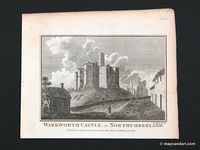Annotation:Warkworth Castle: Difference between revisions
No edit summary |
No edit summary |
||
| Line 3: | Line 3: | ||
<p><font face="garamond, serif" size="4"> | <p><font face="garamond, serif" size="4"> | ||
'''WARKWORTH CASTLE.''' AKA and see “[[Hey to Couper]]," "[[Hey to Cowper]].” English, Scottish; Jig (6/8 time). D Major. Standard tuning (fiddle). AABB. Warkworth Castle [http://en.wikipedia.org/wiki/Warkworth_Castle], Warkworth, Northumberland, dates to the mid-12th century. | '''WARKWORTH CASTLE.''' AKA and see “[[Hey to Couper]]," "[[Hey to Cowper]].” English, Scottish; Jig (6/8 time). D Major. Standard tuning (fiddle). AABB. Warkworth Castle [http://en.wikipedia.org/wiki/Warkworth_Castle], Warkworth, Northumberland, dates to the mid-12th century. | ||
[[File:warkworth.jpg|200px|thumb|left|Warkworth Castle, c. 1786.]] | [[File:warkworth.jpg|200px|thumb|left|Warkworth Castle, c. 1786.]] The cross-shaped keep (dating from the 14th century) is situated on a hilltop that rises steeply above the River Coquet, and though the castle is in disrepair, it is still a magnificent ediface. The most famous inhabitants of the castle were the Percy family, whose lion badge can be seen carved on many parts of their stronghold. | ||
<br> | <br> | ||
<br> | <br> | ||
Revision as of 04:36, 31 May 2015
Back to Warkworth Castle
WARKWORTH CASTLE. AKA and see “Hey to Couper," "Hey to Cowper.” English, Scottish; Jig (6/8 time). D Major. Standard tuning (fiddle). AABB. Warkworth Castle [1], Warkworth, Northumberland, dates to the mid-12th century.

The cross-shaped keep (dating from the 14th century) is situated on a hilltop that rises steeply above the River Coquet, and though the castle is in disrepair, it is still a magnificent ediface. The most famous inhabitants of the castle were the Percy family, whose lion badge can be seen carved on many parts of their stronghold.
Source for notated version:
Printed sources: Aird (Selection of Scotch, English, Irish and Foreign Airs vol. 1), 1782; p. 14. Straight & Skillern (Two Hundred & Four Favourite Country Dances, vol. 1), 1775; p. 102.
Recorded sources:
